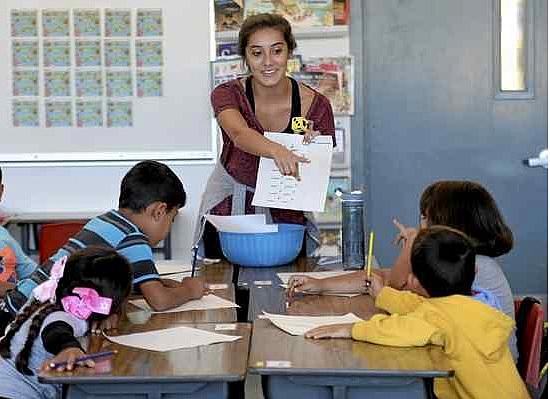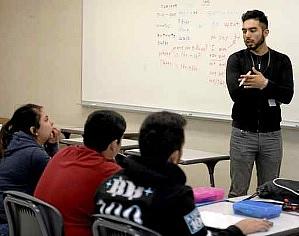Migrant children see themselves in California Mini-Corps teachers
This article, the third in a series on Migrant Education in eastern Solano County, was produced, in part, as a project for the USC Center for Health Journalism’s California Fellowship, a program at the USC Annenberg School for Communication and Journalism.
Other stories in the series include:
Bridging ‘opportunity gap,’ migrant ed students go to STEM camp
Migrant ed in Solano — program focuses on math fluency, reading, robotics

Aimee Carraczo works with first grade students in Dixon Unified Migrant Education program recently at Anderson Elementary School. Carrazco, a student teacher with the organization California Mini Corps, is spending her summer working with children of migrant workers in Dixon. Joel Rosenbaum — The Reporter
In Abilene Martinez, a teaching assistant in Markham Elementary teacher Jose Bermudez’s classroom, a group of middle school-aged migrant students in Vacaville Unified’s summer Migrant Education program see themselves.
Born and raised in Mexico City, Martinez, 25, is the daughter of a migrant worker, Enedina Hernandez, who picks fruit and harvests vegetables on vast Central Valley farms.
A recent graduate of California State University, Sacramento, Martinez, during her weekdays at Markham in June, worked as a member of the California Mini-Corps.
Part of the state’s Migrant Education Program, corps members serve migrant programs and students in grades K-12 during the summer and year-round, depending on a school district’s needs.
Program directors in Region 2, at the Butte County Office of Education, said it gives migrant students, an estimated 200,000 in California and generally regarded as an underserved population with high dropout rates, the academic and social confidence they need to succeed and stay in school.
Fidel Parra, a junior at California State University, Sacramento and also a student teacher with the California Mini-Corps, tutors a group of high school students in English during the Dixon Unified School District Migrant Education Program. Joel Rosenbaum — The Reporter
Every year the program employs hundreds of college students statewide, like Martinez, with rural migrant backgrounds. They serve as teacher assistants and act as role models for migrant children. The program operates at 20 California colleges and universities. Its goals are to develop a group of bilingual-bicultural teachers and provide tutoring services to increase migrant student achievement, which standardized test scores indicate they often lag well behind the general population.
“I always wanted to be a teacher and I love this program,” Martinez said after Bermudez’s students left the aging portable classroom for lunch at the Markham Avenue campus. “It’s definitely helping me a lot.”
She is on her way to reaching her goal.
After facing myriad challenges to graduate earlier this year, she enrolled in the teacher credential program at Sacramento State.
“I never thought I was going to graduate,” said Martinez, a congenial young woman, with a round face and the requisite patience to handle 20 exuberant preteen students. “I worked so hard to reach that goal.”
A graduate of Yuba City High School, she reflected on her time in California public schools, admitting to “being amazed” at her journey so far and her mother’s sacrifices.
While never living a consistently middle-class life, Martinez said, “I don’t remember going hungry,” and confessed to ongoing struggles with mastery of English.
She remembered being bullied and ridiculed in school for lack of English fluency, but Martinez always managed to befriend other migrant students for support and understanding.
“We were learning English” at the time, she said. “But that doesn’t mean we were dumb.”
Though she struggled with English then, Martinez said her enrollment in her high school’s AVID (Advancement Via Individual Determination) program made her realize college was attainable. (Among other things, the program pays for student visits to nearby college campuses.)
“That’s when I learned I could go to college,” she said of AVID, which prepares students for success in high school, college and a career, especially students traditionally underrepresented in higher education.
Martinez, a Mini-Corps member for the past six years, called her students “angels” and strives to be a role model for them.
“I want them to see an example in me,” she said, smiling. “They can relate.”
The California Mini-Corps has long had a presence in Dixon Unified, where, through early August, more than 170 migrant children, elementary through high school students, were enrolled in the summer session.
In late June at Anderson Elementary, Aimee Carrazco worked in teacher Beth Kom’s classroom, filled with more than a dozen first- and second-grade migrant students.
A recent graduate of Dominican University in San Rafael, Carrazco was in her fourth week at the East C Street campus, helping the students understand their assignments in an English-only environment.
Understandably, learning English remains a major challenge for the young students, and some are making gains more rapidly than others, she said.
“They’re very open to asking for help and they’re very trusting,” Carrazco, 21 and a Sacramento native, said during a brief interview under a shade tree next to the school’s playground.
She became interested in joining the Mini-Corps, in part, because she plans on pursuing a law degree, with a concentration in immigrating law, at the University of San Francisco.
“I know my parents struggled,” said Carrazco, who clearly empathized with the youngsters.
At Dixon High, Fidel Parra, 23, helps to translate into Spanish certain parts of their assignments, so the students, in grades nine to 11, at least have some idea what it is they are learning.
A junior at Sacramento State, he can relate to the students’ struggle with English, since, after being born in Watsonville, he returned to Mexico for more than a dozen years. There, in Durango State, the academic curriculum was not as structured or as challenging compared to that in U.S. public schools, he said, seated under canopied outdoor lunch area at the College Way campus.
So it is understandable, he said, that older migrant students, recently arrived in the United States and attending high school for the first time, struggle with the academic subjects because they are just beginning to develop fluency in speaking, writing and reading English.
Parra, who speaks flawless English, wants to pursue a career in education and to eventually earn a doctoral degree and teach at a college or university.
Martinez and Parra were likely recruited to the Mini-Corps by Juanita Lupercio, who works as a college coordinator, specifically through Sacramento State, for Region 2. She hires and places the Mini-Corps tutors in several counties, including Solano, Yolo, Sacramento and the Sacramento River Delta area.
In an interview Thursday, Lupercio said the recruitment and hiring are dependent on several requirements, notably that the young members be the son or daughter of a migrant worker.
“Or be from the farmworker culture,” she added. “They have to know the struggles that the children go through.”
A natural additional preference is that the Mini-Corps candidates be bilingual, which may include a language other than Spanish, since the Northern California Region 2 migrant community includes a variety of ethnic groups, among them Punjabi, Vietnamese, Hmong and Laotian, noted Lupercio.
Like Martinez and Parra, many Mini-Corps members “are exploring the idea of becoming a teacher,” she said, adding that, if they show the slightest interest, “We say, ‘You might want to get into teaching.’ ”
“But we try to make sure they join for the right reasons,” she said.
Throughout the year, Region 2 supervisors make classroom visits to observe the Mini-Corps members, advising them on helpful teaching strategies and giving them feedback, said Lupercio.
At the same time, she reminds them that they are “role models for the children.”
“We ask them to dress professionally and speak professionally” in the classroom, she said. “They see you and look up to you.”
CALIFORNIA MINI-CORPS AND REGION 2, IN BRIEF
Part of the the state Department of Education’s Migrant Education Program, which is funded by the federal government, the California Mini-Corps serves migrant programs and students in grades K-12, as a way to give those students — generally regarded as an underserved population with high dropout rates — the academic and social confidence they need to succeed and stay in school.
An estimated 200,000 migrant students, including several hundred in eastern Solano County, are eligible for such services in 565 California school districts, more than half of all the state’s districts.
The program seeks to employ college students with rural migrant backgrounds to serve as teacher assistants and to act as role models for migrant children. The program operates at 20 California colleges and universities.
The major goals of the Mini-Corps are two-fold: 1) developing a group of bilingual-bicultural teachers; and 2) providing tutoring services to increase migrant student achievement.
The Mini-Corps achieves these goals through regular year-round and summer tutoring services.
There are more than 20 regional Migrant Education offices statewide, all of them in county offices of education, from Imperial County in the south to Monterey County on the Central Coast to Butte County north of Sacramento.
Solano County’s Migrant Education programs are funded and administered by Region 2 of the state program, housed in the Butte County Office of Education in Gridley. It serves nearly 15,000 students, ages 3 to 21. The director is Kim Guzzetti.
The migrant population in Region 2 includes not only Hispanics but also a wide variety of ethnic groups, among them Punjabi, Hmong, Mien, Laotian, Vietnamese and whites.
The region is divided into three areas: Woodland (serving Solano, Yolo, Yuba, Sacramento, Placer, Napa and El Dorado counties); Santa Rosa (serving Sonoma, Lake, Marin, Mendocino, Humboldt and Del Norte counties); and Oroville (serving Butte, Colusa, Glenn, Lassen, Modoc, Shasta, Siskiyou, and Tehama counties).
[This story was originally published by The Reporter.]

